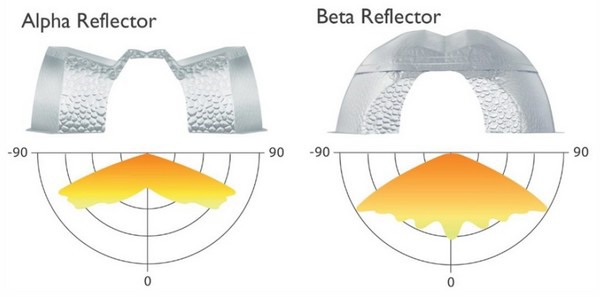Light uniformity is an important factor when it comes to growing a consistent crop and optimizing your growing environment, however, there has been some misinformation about the way HID and LED luminaires distribute light and affect plant health.
Many LED manufacturers like to paint HID luminaires as being an inferior technology. In fact, the same uniformity can be achieved with LED or HID luminaires, and that it depends largely on the light plan and the mounting capabilities of your facility, rather than the luminaire itself. Almost any luminaire can deliver uniform desired light levels in an existing or new infrastructure, as long as there is design freedom from the luminaire manufacturer to layout a custom light plan – as it is mounting heights and luminaire spacing which impacts uniformity.
What is light uniformity?
Light uniformity is the measure of light levels at a specific distance from a light source, at the canopy level, showing the difference in intensity between the highest and lowest measured values. For example, in a light plan with a maximum value of 1000μmol, and a minimum value of 500μmol, the uniformity would be 50%. Light uniformity is important because you need the luminaires’ light output to be distributed evenly across the surface of the crop to ensure even photosynthesis and uniform plant growth. When lighting is not uniform in a growing space, plants can dry out at different times, and you can have some plants developing faster and others slower. Uneven light creates varying daily light integrals (DLI) within a space, creating areas where intensity may be too low―consequently delaying flowering and compromising yields compared to areas of the crop receiving higher intensities.
HID luminaires
As we know, HID luminaires have specialized reflectors to evenly distribute light over the canopy for uniform growth. All reflectors will differ in the amount of light they reflect from the lamp to the canopy of the crop. Reflector patterns, materials and shapes will affect the dispersion of light and how it is distributed.
The light uniformity for HID luminaires, is highly dependent on the reflector and its ability to evenly and efficiently distribute light. Light energy can be wasted with the use of a poorly designed reflector. Reflectors can be designed to allow for wider spacing of luminaires or to focus more energy down into a tall, dense crop like such tomatoes or cucumbers. A well-designed light plan will have even uniformity so there is not a large difference between the lowest and highest values of light intensity measured at the crop.
Reflector design
Some reflectors, like the P.L. Light Systems’ Beta Reflector, are designed to distribute the highest percentage of light from the lamp downwards to penetrate deep within the crop canopy. Whereas as the Alpha reflector is designed to provide a wider range of even light distribution over the canopy.

To avoid wasting light on areas like walls and walkways, P.L. also offers the asymmetrical reflector, which allows you to direct light away from walls/walkways and onto your crop.
As some LED manufacturers have falsely written, the more space between each luminaire and the crop surface, the more uneven the light distribution. Again, this is not true typically true for HID luminaires because of the reflector, which evenly distributes light and creates light crossover—creating high levels of uniformity. In fact, you tend to get better light dispersion from the diffused light (light coming from different directions) emitted by a reflector, because it will cover a greater amount of plant surface. Many of our greenhouse growers, who use HID luminaires, have them installed at a significant height in the greenhouse and receive excellent uniformity over the crop. As you can see below, the NXT2 with Alpha reflector, provides an even cross over of light with a uniformity around 90% and an average light level of 188.9 µmol/m2/s when installed at a height of 1.72meters or 5.6ft above the canopy, and positioned 1.92m, or about 6.2 feet apart.
LED Luminaires
In general, you will need fewer HPS luminaires than LED luminaires to achieve the same uniform light intensity over a crop. This is because the luminaire spacing will likely be different for an LED installation vs. that of an HPS, due to the difference in the light distribution patterns between the two sources. As mentioned, light penetration into the crop comes from the crossover between fixtures which is easily accomplished by HPS luminaires. Whereas LED luminaires, will likely need to be arranged in a different configuration, due to the directional distribution of light, in order to achieve higher uniformity over the crop canopy. This arrangement will be specific to the design of the luminaire.
So, if properly installed according to a light plan, LEDs will provide the same uniformity over a crop as HID luminaires, but will likely have different spacing requirements and can require up to 2-3 more luminaires to achieve the same uniformity at the same desired light level.

